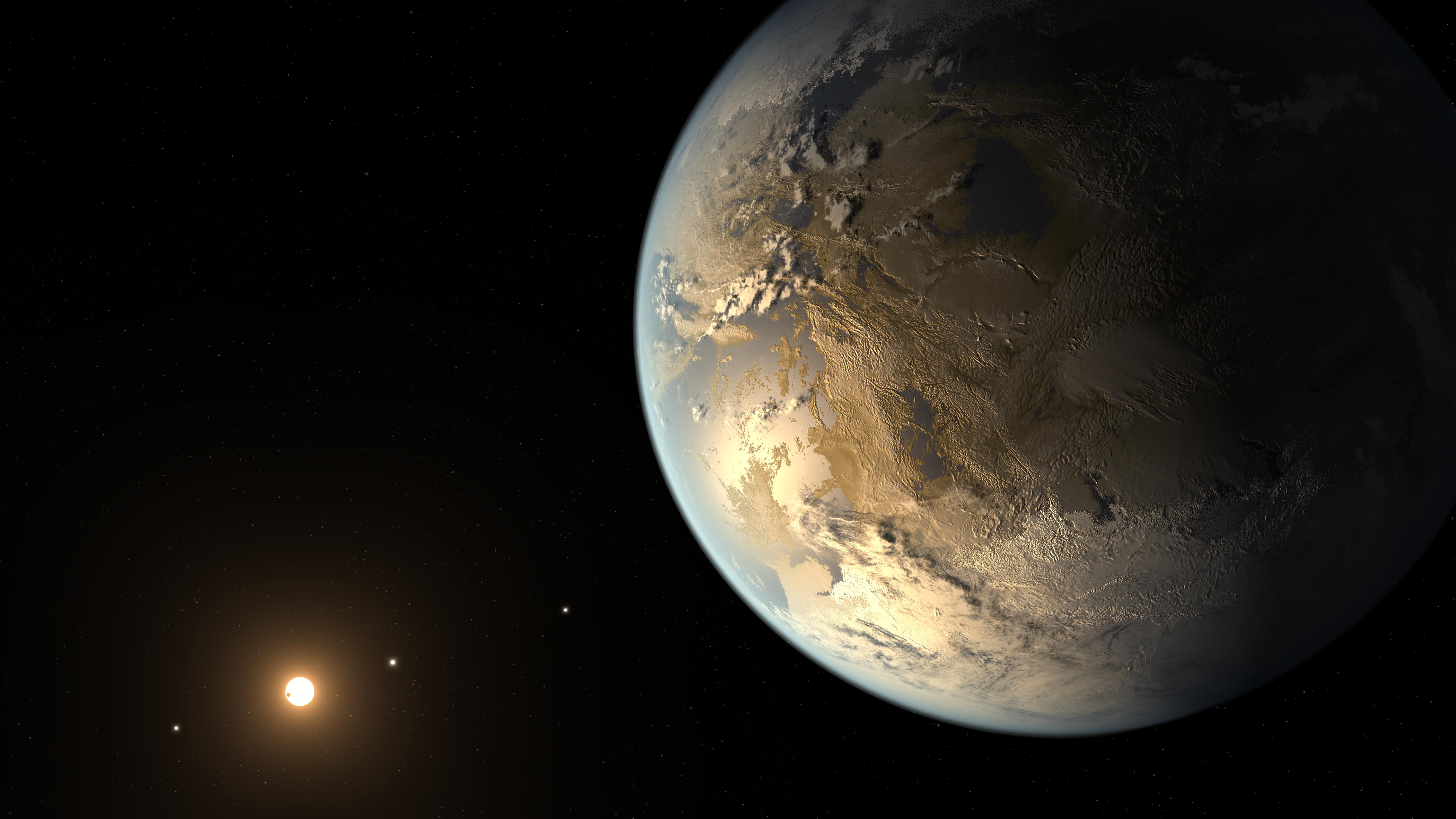Superhabitable planets: Alien worlds that may be more habitable than Earth
Bigger, better, more suited for biology: let's not overlook superhabitable planets with potential.

A superhabitable planet is a world that might have an even better chance at hosting life than our own home, Earth.
Because Earth is the only known inhabited planet and its life depends on liquid water, efforts to identify exoplanets that could host life focus on Earth-like worlds. But some researchers think there are other types of planets that could offer conditions for life as good as — or even better than — Earth. In fact, some scientists argue that focusing only on Earth-like worlds might be too "anthropocentric and geocentric," blinding us to the possibilities of exobiology.
"We are so over-focused on finding a mirror image of Earth that we may overlook a planet that is even more well-suited for life," Dirk Schulze-Makuch, an astrobiologist at Washington State University and the Technical University of Berlin, told Space.com.
How do scientists look for superhabitable planets?
To search for potentially superhabitable exoplanets, Schulze-Makuch and his team investigated the Kepler Object of Interest Exoplanet Archive, focusing on 4,500 planetary systems that likely possessed rocky planets within their stars' habitable zones, where liquid water can persist. The researchers published their findings in a 2020 paper in the journal Astrobiology.
In addition to looking at planetary systems with yellow dwarf stars like our sun, the scientists also looked at orange dwarf stars, which are cooler, dimmer and less massive than our sun.
"Our sun is actually not the best kind of star for hosting a planet with lots of life on it," Schulze-Makuch told Space.com.
Orange dwarf stars are about 50% more common than yellow dwarfs in the Milky Way. Whereas our sun has a lifetime estimated at less than 10 billion years, orange dwarfs have lifetimes of 20 billion to 70 billion years. Since complex life took about 3.5 billion years to appear on Earth, the longer lifetimes of orange dwarf stars could give planets within their habitable zones more time to develop life and accrue biodiversity.
Earth is about 4.5 billion years old, so the researchers speculated the sweet spot for life would be a planet between 5 billion to 8 billion years old.
The size and mass of a planet can also influence how well it can support life, the researchers wrote. A rocky planet that is larger than Earth would have more habitable surface area, and potentially a thicker, more stable atmosphere. A planet with about 1.5 times Earth's mass would likely retain its interior heat longer, which in turn would help keep its core molten and its protective magnetic field active for a greater timespan in which life might have the chance to arise and evolve.
Worlds that are slightly warmer than Earth by about 8 degrees Fahrenheit (5 degrees Celsius) might be superhabitable, since they could have larger tropical zones which on Earth foster more biodiversity. However, warmer planets might also need more moisture, since greater heat could expand deserts.
In addition, planets with the same amount of land area as Earth but broken up into smaller continents might be more habitable. When continents become particularly large (such as Earth's past continent Gondwana, about 500 million years ago), their centers are far from oceans, often rendering the interiors of large continents vast, inhospitable deserts. Moreover, Earth's shallow waters have a greater biodiversity than its deep oceans, so scientists speculate that planets with shallower waters could support more life.
What are some superhabitable planets?
All in all, Schulze-Makuch and team identified 24 potentially superhabitable planets. None of these worlds met all the criteria the researchers drew up for superhabitable planets, but one did meet at least two — KOI 5715.01.
KOI (Kepler Object of Interest) 5725.01 is a planet about 5.5 billion years old and 1.8 to 2.4 times Earth's diameter orbiting an orange dwarf about 2,965 light-years away. It might have an average surface temperature about 4.3 degrees F (2.4 degrees C) cooler than that of Earth, but if it has more greenhouse gases than Earth to trap heat, it might be superhabitable, the researchers wrote.
Schulze-Makuch's own favorite potentially superhabitable world from these 24 was KOI 5554.01. This planet is about 6.5 billion years old, with a diameter 0.72 to 1.29 times that of Earth, orbiting a yellow dwarf about 700 light-years from Earth.
"I really liked the average surface temperature — about 27 degrees C [80 degrees F]," Schulze-Makuch said. "And it's probably about Earth's size, and a little bit older than Earth."
All 24 of these potentially superhabitable planets are more than 100 light-years from Earth. This makes them too far for NASA's Transiting Exoplanet Survey Satellite (TESS) spacecraft to capture high-quality images from to learn more about them.
Still, Schulze-Makuch noted that future spacecraft, such as the newly launched James Webb Space Telescope, NASA's LUVOIR space observatory mission concept and the European Space Agency's PLATO space telescope, could shed light on these worlds.
"We caution that while we search for superhabitable planets, that doesn't mean that they necessarily contain life," Schulze-Makuch said. "A planet can be habitable or superhabitable but uninhabited."
Additional resources and reading
If you're thrilled by the idea of exoplanets, poke around the NASA Exoplanet Archive yourself! If you want to read more about how different and bizarre other planets might be, dive in to astronomer Michael Summers and physicist James Trefil's 2017 book "Exoplanets: Diamond Worlds, Super Earths, Pulsar Planets, and the New Search for Life beyond Our Solar System." And for anyone looking to dream about living on another world, get lost in this TED playlist about becoming — and thriving as — an extraterrestrial.
Bibliography
- Brennan, Pat. "The Habitable Zone | The Search For Life." Exoplanet Exploration: Planets Beyond our Solar System, April 2, 2021. https://exoplanets.nasa.gov/search-for-life/habitable-zone.
- Schulze-Makuch, Dirk, René Heller, and Edward Guinan. "In Search for a Planet Better than Earth: Top Contenders for a Superhabitable World." Astrobiology 20, no. 12 (December 1, 2020): 1394–1404. https://doi.org/10.1089/ast.2019.2161.
Join our Space Forums to keep talking space on the latest missions, night sky and more! And if you have a news tip, correction or comment, let us know at: community@space.com.
Get the Space.com Newsletter
Breaking space news, the latest updates on rocket launches, skywatching events and more!

Charles Q. Choi is a contributing writer for Space.com and Live Science. He covers all things human origins and astronomy as well as physics, animals and general science topics. Charles has a Master of Arts degree from the University of Missouri-Columbia, School of Journalism and a Bachelor of Arts degree from the University of South Florida. Charles has visited every continent on Earth, drinking rancid yak butter tea in Lhasa, snorkeling with sea lions in the Galapagos and even climbing an iceberg in Antarctica. Visit him at http://www.sciwriter.us
- Vicky SteinContributing Writer










